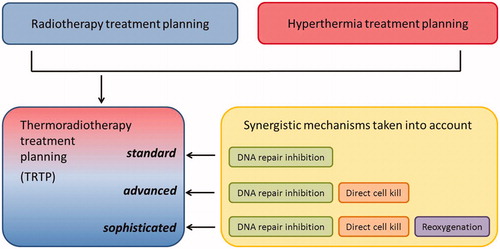Figures & data
Figure 1. The effect of sequence and interval between radiotherapy and hyperthermia on the thermal enhancement ratio (TER) for tumour (left) and skin (right) for C3H mammary adenocarcinoma implanted in the hind limb of mice, redrawn from [Citation38]. Part of the thermal enhancement in tumour tissue appears to be due to an additive effect of hyperthermia, this component appears to be absent in the thermal enhancement in normal skin tissue.
![Figure 1. The effect of sequence and interval between radiotherapy and hyperthermia on the thermal enhancement ratio (TER) for tumour (left) and skin (right) for C3H mammary adenocarcinoma implanted in the hind limb of mice, redrawn from [Citation38]. Part of the thermal enhancement in tumour tissue appears to be due to an additive effect of hyperthermia, this component appears to be absent in the thermal enhancement in normal skin tissue.](/cms/asset/9135e2bd-c7eb-4502-9389-228ed9e61626/ihyt_a_1110757_f0001_c.jpg)
Figure 2. Schematic illustration of the thermal enhancement ratio TER given in arbitrary units (a.u.) for three different HT mechanisms as function of temperature (left) and as a function of the time interval between RT and HT (right). The RT session is given at time t = 0.

Figure 3. Schematic representation of the requirements for thermoradiotherapy planning (TRTP). The first generation of TRTP software should incorporate the DNA repair inhibition mechanism. To improve reliability, later generations should be extended with direct cell killing and reoxygenation.

Figure 4. Example of a treatment planning with dose distributions for radiotherapy alone and equivalent dose distributions for combined radiotherapy and hyperthermia for two prostate cancer patients with a low (case 1) and a high median temperature (case 2) [Citation23]. The 95% isodose level gives better tumour coverage for RT + HT in both cases, particularly in the region close to the rectum.
![Figure 4. Example of a treatment planning with dose distributions for radiotherapy alone and equivalent dose distributions for combined radiotherapy and hyperthermia for two prostate cancer patients with a low (case 1) and a high median temperature (case 2) [Citation23]. The 95% isodose level gives better tumour coverage for RT + HT in both cases, particularly in the region close to the rectum.](/cms/asset/9828967d-4bed-4563-9402-4a24c4d2f477/ihyt_a_1110757_f0004_c.jpg)
